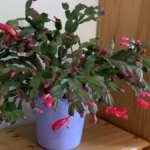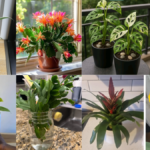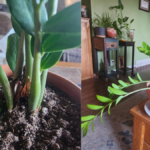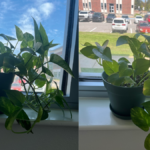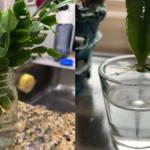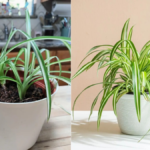Dieffenbachia plant care is simple and rewarding if you understand its basic needs. This tropical indoor plant, also known as Dumb Cane, is loved for its large green and cream-colored leaves. It grows well indoors and adds freshness to any room. In this post, I am sharing my own experience of growing and maintaining Dieffenbachia plants at home.
My Experience with Dieffenbachia
I have been growing Dieffenbachia for many years in my home garden. From my experience, this plant is easy to care for, even for beginners. It adjusts well to indoor conditions and grows fast when given the right light and moisture. However, it also teaches patience because overwatering or direct sunlight can harm it. With proper care, it stays green and healthy throughout the year.
IN THIS ARTICLE
About the Dieffenbachia Plant
| Common Name | Dieffenbachia, Dumb Cane |
|---|---|
| Scientific Name | Dieffenbachia seguine |
| Type | Tropical indoor plant |
| Native Region | Central and South America |
| Light | Bright, indirect light |
| Watering | Keep soil slightly moist |
| Toxicity | Toxic if eaten by pets or humans |
| Growth | Fast-growing foliage plant |
Dieffenbachia is a tropical plant that grows naturally in shaded forest areas. Because of that, it prefers indirect sunlight and slightly warm, humid conditions indoors.
Quick Care Tips for Dieffenbachia Plant Care
- Keep the plant in bright, indirect sunlight.
- Water only when the top one inch of soil feels dry.
- Maintain room temperature between 18–30°C.
- Mist the leaves regularly to maintain humidity.
- Use well-draining potting soil.
- Feed with a liquid fertilizer every 4–6 weeks.
- Avoid keeping near fans, AC vents, or heaters.
Watering the Dieffenbachia
Watering is one of the most important parts of Dieffenbachia care. From my experience, the plant prefers slightly moist soil, not soggy.
- Before watering, check if the top layer of soil is dry.
- Water deeply until water comes out of the drainage hole.
- In summer, I water about two to three times a week.
- In winter, I reduce it to once a week.
Too much water can cause root rot, so I always make sure my pot has a proper drainage system.
Best Light for Dieffenbachia
Dieffenbachia grows best in bright but indirect sunlight.
- Direct sunlight can burn its leaves.
- Low light can make the plant weak and slow its growth.
- A spot near an east or north-facing window works best.
If the plant starts leaning toward light, I rotate the pot every few days for even growth.
Ideal Temperature and Humidity
This plant prefers a warm, comfortable environment.
- Ideal temperature: 18°C to 30°C.
- It dislikes sudden temperature changes.
- Keep it away from direct cold air or strong heat.
For humidity, I mist the leaves every two days or keep a tray of water with small pebbles under the pot. This helps maintain moisture around the plant.
Soil for Dieffenbachia
The right soil helps roots breathe and grow healthy. I prepare my own potting mix at home using:
- 40% garden soil
- 30% coco peat
- 20% perlite or sand
- 10% compost or vermicompost
This mixture keeps the soil soft, drains excess water easily, and gives the plant good nutrients for growth.
Fertilizing the Plant
Dieffenbachia doesn’t need heavy feeding. I usually use a balanced liquid fertilizer (10-10-10) every 4–6 weeks during the growing months (March to September).
- Always dilute the fertilizer before using it.
- Do not fertilize in winter.
Sometimes, I also use liquid compost tea or seaweed solution once a month for natural nourishment.
Homemade Fertilizer for Indoor Plants – My Easy
Pruning and Maintenance
Regular pruning keeps the Dieffenbachia plant neat and attractive.
- Remove any yellow or dry leaves.
- If the plant grows tall and leggy, trim the upper part.
- New leaves will grow from the cut stem after a few weeks.
Always wear gloves while pruning because the sap can irritate the skin.
How to Propagate Dieffenbachia
Propagating Dieffenbachia is very simple. I often grow new plants from stem cuttings.
Here’s how I do it:
- Take a healthy stem about 6–8 inches long.
- Remove lower leaves, leaving only a few at the top.
- Place the cutting in water or directly into moist soil.
- Keep it in bright, indirect sunlight.
- Roots appear within 2–3 weeks.
Once roots are strong, I transfer the cutting into a pot with fresh soil. The new plant starts growing within a month.
Common Problems and Solutions
| Problem | Reason | Solution |
|---|---|---|
| Yellow Leaves | Overwatering or poor drainage | Reduce watering and check soil drainage |
| Drooping Leaves | Underwatering or cold air | Water regularly and keep in warm place |
| Brown Leaf Tips | Low humidity or too much fertilizer | Mist leaves often and feed lightly |
| Slow Growth | Lack of light or nutrients | Move to a brighter spot and fertilize monthly |
My Personal Observation
Over the years, I’ve noticed that Dieffenbachia responds quickly to good care. If I miss watering for too long, the leaves droop, but after watering, they stand tall again within hours. It’s a forgiving plant that gives a clear signal when something is wrong. I love keeping it indoors because its large, patterned leaves make any corner look fresh and alive.
Conclusion
To summarize, Dieffenbachia plant care depends on maintaining the right balance of light, moisture, temperature, and humidity. Avoid overwatering, provide bright but indirect sunlight, and keep the soil well-drained. With regular care and attention, this tropical plant will grow beautifully and stay healthy for years.

